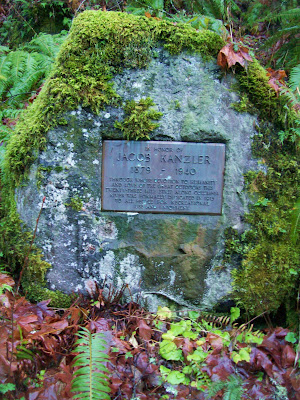HCRHST stands for the Historic Columbia River Highway State Trail. My son and I are attempting his first end-to-end which turned out to be about 90 miles. For pictures and back story check out these links: Getting Ready, Day 1, Day 2, Day 3, Day 4, Day 5, Pictures, and Progress.
This is the portion of our trip where things began to get a bit crazy. Now, you may say that not having a hotel was crazy, or that sleeping through extreme weather warnings was crazy, or even hitchhiking with your small child was crazy, but all that was sort of par for the course on a long distance trip especially through our Gorge in January.
When we hit our third extreme weather advisory in Eagle Creek it was due to flooding. The rain began to come and it just didn't stop. It transformed from rain into pouring and continued for 2 days solid. This combined with the fact it had warmed up only enough to not be snowing and the ground was melting off. We got updates from the Rangers that went something like this: "You cannot continue, all trails are closed," or "We have rerouted some of the major trails as things appear to be letting up, but it is still not safe to continue," or "Nope, you can't go on. Multnomah Falls is even closed due to snow melt combined with the flooding. " When that one was announced I knew we might actually have to end. The only other time this major tourist attraction has been closed was in the now fabled Floods of '96. During that time the Willamette River rose over 10 and a half feet. A foot of that was in under 3 days. We get serious rain here. Since we didn't have a television or the Internet to watch, I couldn't really tell just how bad it was elsewhere. So the map was pulled out and we tried to figure out a new game plan as the information streamed in.
Luckily, Eagle Creek is an incredible spot to be holed up. In the 1840's this is the place where intrepid Oregon Trail folks would place their wagons on rafts and float them down the Columbia hoping for the best. By the late 1800's steamers were popular here and ferried all sorts of cargo up and down the Gorge allowing commerce to the settlements. Due to such popular traffic, in 1915 The Columbia River Gorge Park was established as a unit of the Oregon National Forest system. This was the first time in our nation's history that any part of land was set aside for exclusively recreational use. The very small space (23 miles by about 5 miles wide) was set aside from timber use, resort population, and even mining.

So as the rain poured down around us, The Barracuda and I slept in the first campground to ever be established in a National Forest. In the first two years the campground was established (1915-1917) more than 150,000 people would sleep here and use the Eagle Creek Trail. This action set the precedent to be followed by the rest of the nation in the National Parks system. We read Call of the Wild, listened to the eagles scream overhead catching fish, and tried to stay as dry as possible. It seems like such a simple act, but connecting with that kind of history has been important to our family. We want our son to see that if it weren't for the early days of preservation, much of what he knows just wouldn't exist.














1 thoughts:
That sounds really cool--Eagle Creek, not the incessant rain. I went to grad school in Eugene and was amazed at how much it rained (and I had already lived in coastal northern Cali (Arcata) where it rains a lot). I didn't know about Eagle Creek, though, so that will have to go on our list of places to visit. The Barracuda is lucky to have these amazing experiences--he's going to be a tough kid!
Post a Comment